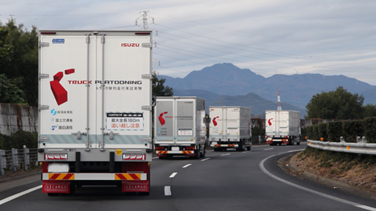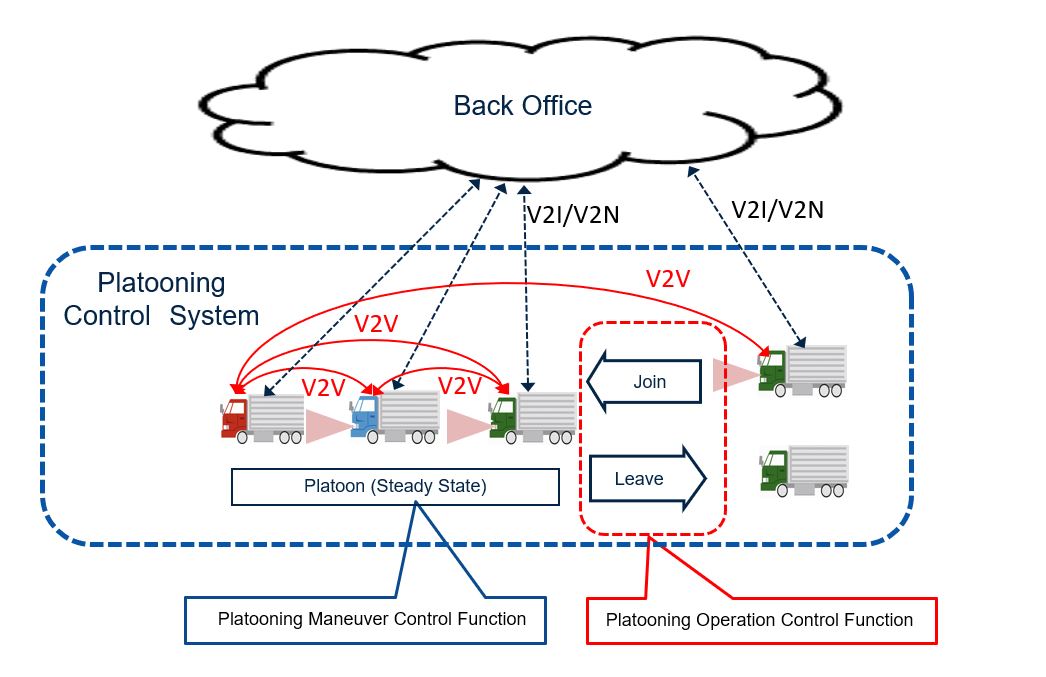- Home
- News Releases
- Back Issues
- September FY2022
- New International Standard Issued for Truck Platooning Systems Proposed by Japan
New International Standard Issued for Truck Platooning Systems Proposed by Japan
- Aiming for a safer and more efficient society (ISO 4272) -
September 21, 2022
Trucking makes up the majority of domestic logistics. Therefore, state-of-the-art technologies for trucking will bring about great benefits if they can improve safety and fuel efficiency, retain workers, and alleviate traffic congestion.
"Platooning" is a technology that allows multiple trucks to travel in a platoon, telecommunicate driving conditions to each other in real time, and autonomously maintain distance between each other. Internationally promoting widespread use of this technology requires a common approach to developing the driving systems and functions.
An international standard proposed by Japan for these systems has been issued. The use of truck platooning systems is expected to lead to solutions to the shortage of logistics workers and to improve logistics efficiency.
1. Background
Trucking—the major pillar of domestic logistics—is facing challenges such as driver shortages, aging drivers, and rising fuel costs. Truck platooning is expected to help reduce traffic accidents caused by driving errors that happen due to fatigue, improve fuel efficiency by reducing air resistance and vehicle speed changes, alleviate traffic congestion by minimizing speed drops in areas that go from downhill to uphill (sag sections), and retain workers by reducing the driving burden. Against this backdrop, a system for truck platooning was developed, and was tested on the Shin-Tōmei Expressway and other public roads for the first time in January 2018.
"Platooning" in this standard refers to a technology supervised by on-board drivers that allows multiple trucks to travel in a platoon on expressways, telecommunicate driving conditions to each other in real time, autonomously maintain distance between each other, and change or stay in lanes in coordination.
Studies on the practical application of platooning have also been taking place in countries around the world, including those in Europe and the United States. Developing internationally unified standards was considered crucial.
Therefore, based on results obtained from the development of and demonstration tests on the vehicle technology in Japan, Japan proposed an international standard with the aim of spreading systems with common functions to the wider world.

Figure 1: Truck platooning demonstration test
2. Outline of the standard
ISO 4272 (Truck platooning systems)1—the international standard issued this time—defines a function governing how vehicles form, join, and leave platoons (the platooning operation control function) and another function governing platooning maneuvers (the platooning maneuver control function). (Figure 2)
Standardizing these functions will enable vehicles of different brands to share information on any vehicle joining the platoon, and to form a platoon by adjusting their speed in coordination with other vehicles as they join.
- Platooning operation control function: A function for vehicles and platooning controllers to share information and govern how vehicles form, join, and leave a platoon.
- Platooning maneuver control function: A function for vehicles to share acceleration and deceleration information, and maintain the distance between each other and keep or change lanes based on Cooperative Adaptive Cruise Control (CACC2).
The standard also defines different cases in platooning such as platoon formations, common telecommunication data items to enable information sharing between vehicles of different brands, and evaluation methods for platooning functions.
Japan proposed this standard to the International Organization for Standardization (ISO) TC204 (intelligent transport systems) WG14 (vehicle/roadway warning and control systems), of which Japan serves as the international chair, in April 2019, and it was issued as an international standard on September 19, 2022.3

Figure 2: Concept diagram of the truck platooning system
3. Expected effects
The issuance of this standard will enable operators to develop truck platooning systems and functions based on a common definition. The use of such systems is expected to reduce traffic accidents caused by driving errors that happen due to fatigue, improve fuel efficiency by reducing air resistance and speed changes, alleviate traffic congestion by minimizing speed drops in sag sections, and retain drivers by reducing the driving burden.
ISO 4272:2022 Intelligent transport systems — Truck platooning systems (TPS) — Functional and operational requirements
Related links
- International Organization for Standardization (ISO 4272:2022)

- ITS Standardization 2021, Society of Automotive Engineers of Japan, Inc.

Division in Charge
International Standardization Division, Industrial Science and Technology Policy and Environment Bureau